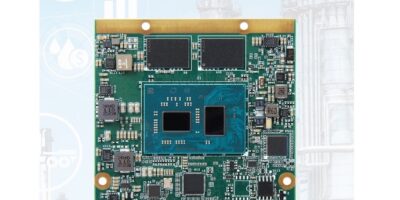Embedded QSeven 2.1 module doubles graphics speed for signage and retail
Multi-threading computing performance is improved by a factor of 1.5 in the PQ7-M109 embedded QSeven 2.1 module, says Portwell.
The module is based on the Intel X6000E series processors, formerly known as Elkhart Lake, and also doubles the speed of graphics performance, compared to the previous generation, continues the company.
The latest addition to Portwell’s portfolio of embedded Qseven solutions has Intel Atom x6000E series/Celeron/Pentium processor based on 10nm technology. The modules supports up to four cores with 4.5 to 12W thermal design power (TDP) and integrates the Intel Gen 11 UHD graphics engine with triple display support in 4K resolution.
The PQ7-M109 features on-board LPDDR4 3200M transfers per second with in-band ECC (IBECC) up to 8Gbyte which allows more affordable standard memory to be used instead of ECC memory (ECC or Non-ECC can be configured by BIOS) and can improve safety and reliability, says Portwell. There is also onboard eMMC 5.1 up to 256Gbyte, triple independent displays that include dual-channel LVDS up to 1920×1200 at 60Hz, which can be swapped for eDP, and two other DDI options to either DisplayPort 1.4 or HDMI 2.0b up to 4K resolution. Other features are two USB 3.2 Gen 1, six USB 2.0, two SATA III, four PCIe Gen 3 x1, one Gigabit Ethernet and other I/O interfaces such as SDIO, I2C, HDA, JTAG, SMBus, LPC, CAN bus and UART. The modules supports ACPI 5.0 power management and fully integrated voltage regulator (FIVR). It also supports a wide operating temperature range from -40 to +85 degrees C. There is also on-board TPM 2.0 for security.
“In addition,” Peter Ahne states, “our new PQ7-M109 module supports new advanced features that boost IoT designs from the edge to the Cloud, including Enhanced Integration with Intel Programmable Service Engine (PSE), an ARM™ Cortex™ M7-based management engine/co-processor to reduce CPU load and provide IoT functions such as remote out-of-band (OOB) device management that provides access/power control to edge devices even when they are powered down or the OS is unresponsive. These new advanced features also include the fully integrated voltage regulator (FIVR) for power management with simplified design, plus the support of Intel OpenVino™ toolkit and Media SDK to improve performance and accelerate video inferencing workload.”
Built with qualified industrial grade components, Portwell’s PQ7-M109 module is ideal for edge devices that need high performance and low power consumption and especially for applications such as industrial automation, factory automation, process control, embedded system for IIoT, edge computing, medical/healthcare equipment, manufacturing, intelligent gateway, and transportation. It’s also suitable for graphic-intensive applications including gaming, digital signage, smart retail and much more.
Significantly Improved Performance and Lower Power Consumption
According to Peter Ahne, marketing director for Portwell Europe, the PQ7-M109’s small form factor is suitable for compact systems where space is at a premium. In addition to thermal and computing performance that improves on its predecessor, it supports triple independent displays with selectable options that support up to 4K resolution.
“We have also made it easy for existing customers to upgrade from the previous Qseven module so they can quickly and easily take advantage of the higher performance and lower power consumption of the new PQ7-M109,” adds Ahne.




